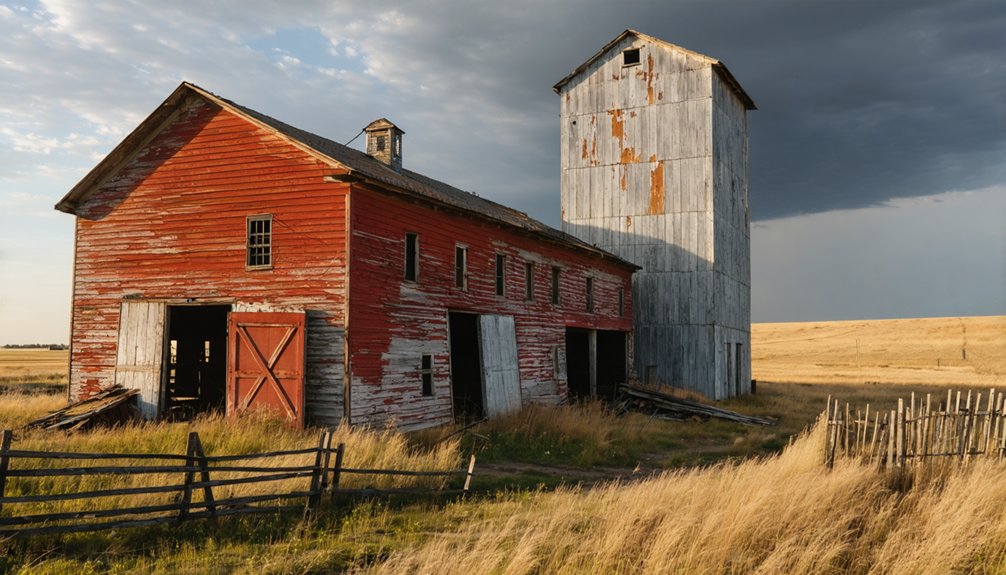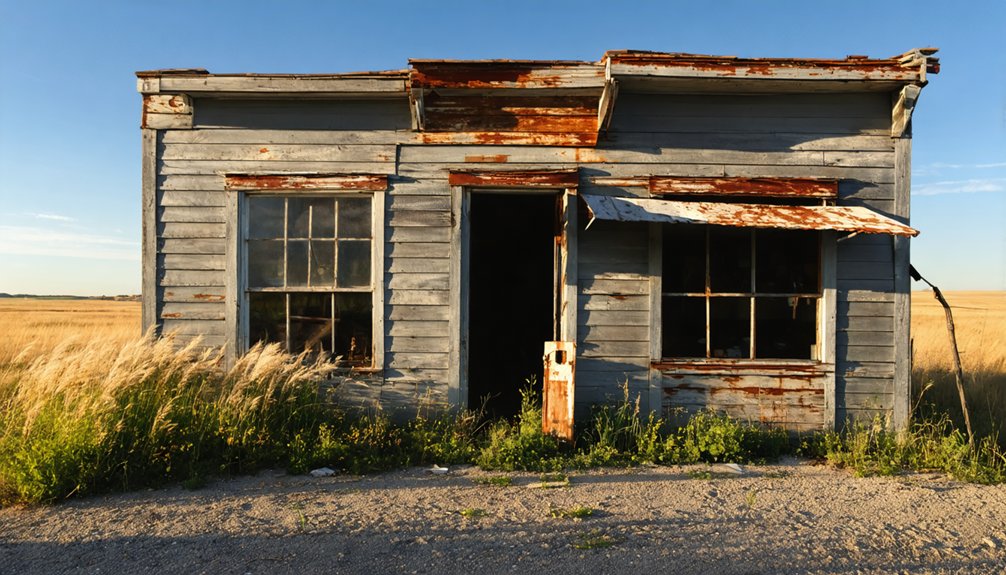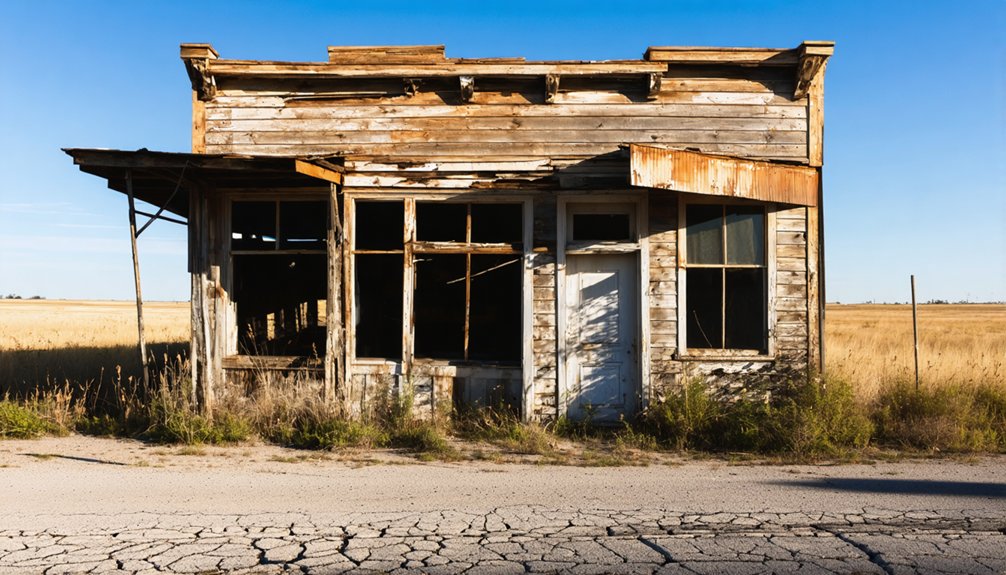You’ll find Devoe’s ghost town remains in Faulk County, South Dakota, where pioneer settlers Emma and John DeVoe established their community in 1883. While the town initially showed promise with 27 residents by 1900, its fate was sealed when railroad companies bypassed the settlement, leading to economic isolation and eventual abandonment. Today, no structures remain in this barren site, though archaeological evidence still tells stories of frontier life and unfulfilled dreams of prairie prosperity.
Key Takeaways
- Devoe was founded in 1883 by Emma and John DeVoe as a potential railroad town but was abandoned after rail lines bypassed it.
- The town reached a peak population of 27 residents by 1900 before experiencing steady decline due to economic isolation.
- Failed railroad connections led to agricultural shipping difficulties and business closures, ultimately causing the town’s abandonment.
- Pioneer settlers built sod houses and dugouts, establishing basic services like general stores and blacksmith shops during the 1880s.
- Today, Devoe is completely abandoned with no remaining structures, having reverted to empty fields in Faulk County, South Dakota.
The Railroad Dream That Never Was
When settlers established Devoe, South Dakota in 1883, they envisioned a bustling railroad town that would connect their agricultural community to major markets. Named after the DeVoe family, the town’s founders based their railroad expectations on promising surveys and initial plans that included routes through Faulk County.
Like other settlements competing for railway access, communities engaged in last-minute efforts to attract rail lines to their areas.
Local suffragist organizers like Emma Smith DeVoe moved to Dakota Territory in 1881 during this period of railroad expansion.
You can see how these hopes were ultimately dashed when railroad companies shifted their focus westward and consolidated operations.
As rail development slowed after 1887 due to economic downturns and drought, Devoe faced increasing economic isolation. Without the essential transportation link that railroads provided, local businesses and farmers couldn’t compete with nearby towns that had depots.
They struggled with higher costs and limited market access, setting the stage for Devoe’s eventual abandonment.
Early Settlement and Pioneer Life
The story of Devoe began with J.H. DeVoe and his family arriving in Faulk County in 1882, establishing their homestead in Township 119, Range 67. Like many settlers during Dakota Territory’s “Boom of the Eighties,” they faced pioneer hardships while building their new life on the prairie.
You’ll find that early Devoe settlers displayed remarkable community resilience, constructing sod houses and dugouts while supporting each other through harsh weather, prairie fires, and grasshopper plagues. They selected land near water sources, essential for agriculture and livestock, and worked together to “prove up” their claims. The region’s rolling prairie landscape provided abundant natural grasses that supported both wildlife and livestock grazing.
The DeVoes completed this process by 1883, inspiring other families to join their settlement. Despite isolation and limited infrastructure, residents established schools, churches, and social gatherings, creating a tight-knit community built on mutual aid and shared determination. After a year in the community, the DeVoes made the decision to return to Huron, where they would later become active in social causes.
A Glimpse Into 1880S Frontier Development
You’ll find Devoe’s development mirrors many frontier settlements of the 1880s, with hopeful pioneers establishing essential businesses like general stores and blacksmith shops while awaiting promised railroad connections.
The town’s growth relied heavily on local agricultural trade and basic services, including a small doctor’s office and rudimentary law enforcement facilities typical of South Dakota frontier communities. Similar to structures preserved at 1880 Town, these buildings showcased the essential services needed for frontier life. Visitors today can see examples of these period buildings through original artifacts displayed in carefully preserved exhibits.
When the anticipated railroad lines bypassed Devoe, the town’s economic prospects dimmed, leading to its eventual abandonment and transformation into one of South Dakota’s numerous ghost towns.
Railroad Dreams Gone Wrong
During the 1880s, railroad expansion through Dakota Territory sparked intense speculation and development as investors rushed to establish townsites along anticipated rail routes.
You’ll find that railroad companies wielded immense power, controlling not just the tracks but the very planning of towns along their lines. They’d design settlements in a distinctive T-shape pattern, with Main Street running perpendicular to the rail line. The Dakota City Advance promoted growth and development in one such hopeful settlement.
The stakes were high in this railroad speculation game. Local investors like A.M. Bowdle and J.D. Lawler, with access to ready cash, jumped into townsite development.
But you couldn’t just build anywhere – your town’s survival depended entirely on securing that coveted rail connection. Without it, even the most promising settlement risked becoming another prairie ghost town, abandoned to the wind-swept Dakota plains.
Small Town Pioneer Life
Life on South Dakota’s frontier demanded extraordinary resilience from settlers who ventured west in the 1880s. Pioneer resilience was tested daily as you’d work your 160-acre homestead with little more than basic tools and determination. Just as settlers in Awanka relied on the local grain elevator, farming families depended heavily on these vital structures for storing and shipping their harvests. Similar to the many mining communities that rose and fell, frontier towns faced uncertain futures driven by economic changes.
Community cohesion emerged through shared hardships and mutual support, despite the miles between neighboring farms.
Your daily frontier experience would’ve included:
- Building your home from locally sourced materials like sod or wood
- Walking miles to reach the nearest general store or blacksmith
- Gathering at one-room schoolhouses and churches for both education and social connection
- Participating in seasonal festivities and community gatherings to combat isolation
You’d face harsh winters, potential crop failures, and limited medical care while working to establish your piece of the American dream in towns like Devoe.
Lost Frontier Settlement Reality
While frontier towns like Devoe emerged with grand aspirations in the 1880s, their fates often hinged on the promise of railroad development and natural resource exploitation.
You’ll find that pioneer hardships were constant companions in these settlements, where survival depended on successful industries like lumber, cattle, and mining. Like many settlers who received 160 acres of farmland through the Homestead Act, residents faced daunting challenges establishing themselves. Community resilience was tested as populations ebbed and flowed with economic booms and busts.
Despite establishing formal institutions like Devoe’s post office in 1887, these towns remained vulnerable to forces beyond their control.
When railroads bypassed them or natural resources depleted, communities quickly unraveled. The reality of frontier life meant confronting harsh conditions, from drought to disease, while building micro-communities around whatever economic activities could sustain them.
From Bustling Hope to Quiet Decline

You’ll find that DeVoe’s promising start in the 1880s quickly faded when the anticipated railroad expansion failed to materialize through Faulk County.
The town’s population, which had reached 27 residents by 1900, steadily declined as settlers realized their dreams of a transportation hub wouldn’t come true.
Without the railroad to sustain commerce and growth, DeVoe’s remaining residents gradually departed for nearby towns with better economic prospects, leaving behind little more than memories of frontier ambitions.
Railroad Dreams Fade Away
Despite the initial promise of growth when Emma and John DeVoe established their namesake town in 1883, DeVoe’s dreams of securing a significant railroad connection never materialized.
The railroad impact proved devastating, as community isolation left the town struggling to compete with neighboring rail-served settlements.
You can see how the lack of rail access affected DeVoe in four important ways:
- Agricultural profits plummeted due to inefficient transport of grain and farm products
- Essential services like mail and telegrams remained frustratingly limited
- Businesses avoided investing in the town, deterred by high shipping costs
- The absent rail depot meant no central hub for commerce and social gatherings
Without the crucial railroad connection that powered South Dakota’s “Great Dakota Boom,” DeVoe couldn’t sustain the growth its founders had envisioned.
Dwindling Population’s Final Days
As the promised railroad connection failed to materialize, DeVoe’s population began a steady decline that would define its final chapter.
You’d have witnessed the gradual erosion of community cohesion as businesses shuttered and families moved away, seeking better opportunities in larger cities. The town’s economic stagnation became a self-fulfilling prophecy – fewer residents meant a shrinking tax base, which led to deteriorating infrastructure and reduced services.
The remaining buildings fell into disrepair as younger generations left for urban areas, leaving behind aging residents who couldn’t or wouldn’t relocate.
The post-war shifts in agriculture and technology dealt additional blows to DeVoe’s sustainability. What was once a hopeful prairie settlement transformed into another South Dakota ghost town, its empty structures standing as silent testimonies to dreams unfulfilled.
Mapping Devoe’s Historical Footprint
While historical records confirm Devoe’s location in Faulk County’s Township 119, Range 67, pinpointing the ghost town‘s exact footprint presents significant challenges for modern researchers.
The geographic challenges of mapping this vanished settlement are complicated by limited documentation and the passage of time.
If you’re planning to explore Devoe’s historic location, you’ll need to take into account these key mapping elements:
- The town site was positioned along the road between sections 26 and 27
- Historic plat maps serve as the primary source for identifying the settlement’s boundaries
- The Devoe Church and Stock Farm may offer reference points, though their exact relation remains unclear
- Modern satellite imagery and GPS coordinates won’t help, as no visible structures remain
Legacy of a Lost Prairie Town

Beyond the physical coordinates and mapping challenges lies the profound historical impact of Devoe’s rise and fall. You’ll find its story echoes throughout Faulk County, where memories of community resilience persist despite the town’s physical disappearance.
The settlement’s destiny, shaped by unfulfilled railroad promises, mirrors countless other prairie towns that emerged and vanished in South Dakota’s pioneering era.
While visible structures have faded, archaeological insights reveal traces of frontier life through scattered foundations and artifacts. You can still piece together Devoe’s narrative through oral histories passed down by descendants and local historians.
The town’s legacy lives on as a reflection of the transformative power of infrastructure speculation and the delicate balance between human settlement and prairie ecosystems in the American West.
Modern Day Ghost Town Status
Today, Devoe stands as one of South Dakota’s most obscure ghost towns, classified as a barren site with virtually no remaining structures or visible remnants of its frontier past.
Abandoned and desolate, Devoe exists only in memory, its frontier heritage erased from South Dakota’s windswept plains.
Unlike more prominent ghost towns that attract dark tourism enthusiasts, you’ll find Devoe lacks any abandoned infrastructure to explore or photograph.
The town’s current status can be summarized in four key points:
- No permanent residents inhabit the area, with the site having reverted to empty fields.
- Zero preservation efforts or historical markers exist to commemorate the location.
- No organized tours or annual events take place, unlike active ghost town tourism sites like Galena.
- Physical traces are minimal, making it challenging to even pinpoint the town’s original location.
The site’s complete abandonment sets it apart from partially preserved South Dakota ghost towns that still draw visitors.
Frequently Asked Questions
Are There Any Surviving Photographs of Devoe During Its Active Years?
You won’t find surviving photographs from Devoe’s active period in historical documentation or visual archives. While private collections might exist, there’s no publicly accessible photographic evidence of the town’s heyday.
Did Any Notable Crimes or Unusual Events Occur in Devoe?
You won’t find any documented crimes or unusual events from Devoe’s history, as historical records are extremely limited. The town likely faced typical frontier challenges, but specific incidents weren’t preserved.
What Happened to the Original Residents After Leaving Devoe?
You’ll find the original residents scattered like autumn leaves – their historical migration patterns led them to nearby towns like Deadwood and Spearfish, where they rebuilt their lives and communities.
Were There Any Schools or Churches Established in Devoe?
You won’t find any evidence of Devoe education or religion – no schools or churches were established during the town’s brief existence. Historical records and physical remains show no institutional development.
Did Native American Tribes Have Any Significant Interactions With Devoe Settlers?
Like scattered puzzle pieces lost to time, you won’t find documented evidence of tribal relations or cultural exchanges between Native Americans and Devoe settlers in available historical records.
References
- https://www.youtube.com/watch?v=Glucs_Rq8Xs
- https://www.ghosttowns.com/states/sd/devoe.html
- https://www.findagrave.com/memorial/115891694/john_henry-devoe
- https://en.wikipedia.org/wiki/List_of_ghost_towns_in_South_Dakota
- https://www.aberdeennews.com/story/news/2019/05/18/documentary-pays-tribute-to-towns-of-yesteryear/44322743/
- https://www.youtube.com/live/r-wdmY0FpBs
- https://www.sdpb.org/shows/south-dakota-documentaries/clip/vanished-south-dakota-devoe-zw1qtj
- https://www.sdhspress.com/journal/south-dakota-history-49-1/working-on-the-railroad-a-history-of-the-south-dakota-core-rail-system/4901_bucklin.pdf
- https://history.sd.gov/preservation/docs/SDRailroad.pdf
- https://www.sdhspress.com/journal/south-dakota-history-5-2/railroads-and-the-settlement-of-south-dakota-during-the-great-dakota-boom-1878-1887/vol-05-no-2-railroads-and-the-settlement-of-south-dakota-during-the-great-dakota-boom-1878-1887.pdf



